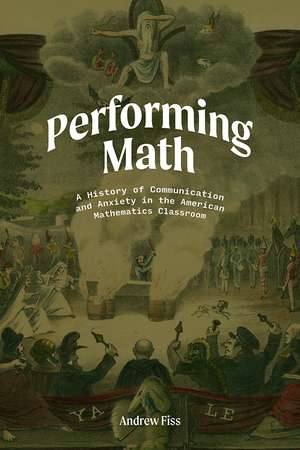Performing Math: A History of Communication and Anxiety in the American Mathematics Classroom
Autor Andrew Fiss Ph.Den Limba Engleză Paperback – 12 noi 2020 – vârsta ani
Performing Math tells the history of expectations for math communication—and the conversations about math hatred and math anxiety that occurred in response. Focusing on nineteenth-century American colleges, this book analyzes foundational tools and techniques of math communication: the textbooks that supported reading aloud, the burnings that mimicked pedagogical speech, the blackboards that accompanied oral presentations, the plays that proclaimed performers’ identities as math students, and the written tests that redefined “student performance.” Math communication and math anxiety went hand in hand as new rules for oral communication at the blackboard inspired student revolt and as frameworks for testing student performance inspired performance anxiety. With unusual primary sources from over a dozen educational archives, Performing Math argues for a new, performance-oriented history of American math education, one that can explain contemporary math attitudes and provide a way forward to reframing the problem of math anxiety.
Preț: 357.83 lei
Nou
Puncte Express: 537
Preț estimativ în valută:
68.47€ • 71.68$ • 56.65£
68.47€ • 71.68$ • 56.65£
Carte indisponibilă temporar
Doresc să fiu notificat când acest titlu va fi disponibil:
Se trimite...
Preluare comenzi: 021 569.72.76
Specificații
ISBN-13: 9781978820203
ISBN-10: 1978820208
Pagini: 216
Ilustrații: 6 b-w images
Dimensiuni: 152 x 229 x 20 mm
Greutate: 0.28 kg
Editura: Rutgers University Press
Colecția Rutgers University Press
ISBN-10: 1978820208
Pagini: 216
Ilustrații: 6 b-w images
Dimensiuni: 152 x 229 x 20 mm
Greutate: 0.28 kg
Editura: Rutgers University Press
Colecția Rutgers University Press
Notă biografică
ANDREW FISS is an assistant professor in technical communication at Michigan Technological University in Houghton, Michigan.
Cuprins
Table of Contents
Preface
Introduction
1 How Math Communication Has Started with Reading Aloud
2 How Math communication Has Been Practiced in Prohibited Ways
3 How Math Anxiety Has Developed from Classroom Tech
4 How Math Communication Has Been Theatrical
5 How Math Anxiety Became about Written Testing
Acknowledgments
Notes
Index
Preface
Introduction
1 How Math Communication Has Started with Reading Aloud
2 How Math communication Has Been Practiced in Prohibited Ways
3 How Math Anxiety Has Developed from Classroom Tech
4 How Math Communication Has Been Theatrical
5 How Math Anxiety Became about Written Testing
Acknowledgments
Notes
Index
Recenzii
"Through an impressive array of evidence and historical accounts, Performing Math convincingly shows that mathematics education has often had a significant theatrical component. Without a doubt this book illuminates mathematics and its place in American culture in new and surprising ways."
"Andrew Fiss’s examination of ways in which American textbook authors, teachers, and students have communicated mathematical ideas over the past two centuries gives new meaning to the phrase classroom performance."
"Performing Math tackles the important topic of mathematics education from a distinctive angle. The author has unearthed fascinating accounts of American students creating performance events out of the seemingly undramatic materials of the mathematics classroom and the mathematics textbook. This book should intrigue anyone with an interest in American history and will be of particular value to historians of mathematics and historians of education."
"With unusual primary sources from over a dozen educational archives, Performing Math argues for a new, performance-oriented history of American math education. It also analyzes a lot of humor about American mathematics in a fun way."
Descriere
Performing Math uncovers math anxiety’s history in stage fright, and how math communication has involved a considerable amount of theatrical performance. Andrew Fiss argues for a new, performance-oriented history of American math education, one that can explain contemporary math attitudes and provide a way forward in reframing the problem of math anxiety.
